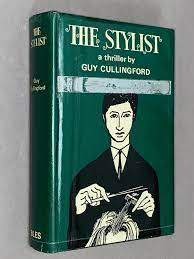The early members of the Detection Club, notably Anthony Berkeley, Dorothy L. Sayers, and Agatha Christie, were all exceptionally interested in the study of true crime cases, and that enthusiasm informed their own work in many ways. I talked about this in some detail in The Golden Age of Murder and it's a subject I plan to return to at a later date. In the meantime, I'm researching widely and I've just read an interesting novel by a Detection Club member of later vintage, Guy Cullingford (whose real name was Constance Taylor) which, in its later stages, reveals the influence of some of the same real life cases that fascinated Berkeley, Sayers, and Christie.
The book in question is The Stylist. It was published in 1968 and was the penultimate Cullingford crime novel (although she also wrote a historical novel a decade or so later). The Stylist is a seriously obscure book. It was never published in paperback or in the United States. I've never read any discussion about it anywhere online, although I have managed to find one contemporary review, from Edmund Crispin, in the Sunday Times. I'd have been unaware of its quality had I not chanced upon an inscribed copy (complete with a photo of the author and a letter from her husband) that caught my fancy.
The jacket describes the book as a 'thriller', but if you're looking for slam-bam action from the get-go, this one is not for you. It's a slow-burn novel, very much character-driven. One ingredient in the story, local government corruption, calls to mind Michael Gilbert's very different The Crack in the Teacup, published two years earlier. Another element is suggestive of yet another very different book, Patricia Highsmith's The Talented Mr Ripley. And the true crime cases which are name-checked late on in the story are those involving Edith Thompson and Alma Rattenbury, which have inspired quite a few crime novels. This one, however, is distinctive.
Laura Chance is a wealthy woman in her fifties married to a dodgy self-made man. She's bored, but when she encounters a new hair stylist, Pierre (an Englishman called Peter) who is half her age, she finds a new interest in life. Slowly, slowly, Cullingford deploys an interesting range of characters in Laura's circle, and in Pierre's, but one can neve be entirely sure where the story is heading. Not much happens for ages, but I was kept gripped by the quality of writing and characterisation. It's subtle and occasionally witty and I really enjoyed it.
And if that isn't enough to encourage you, then I should add that Edmund Crispin, who likened the writing to Trollope, was also enthusiastic. So was Francis Iles, who described it as 'comfortably disturbing throughout...a book not to be missed by the discerning' (with thanks to Arthur Robinson for highlighting the Iles review). What a pity that the book made so little impact - the author must have been very disappointed, because it's clear to me that she took great pains over the writing, and to very good effect.

2 comments:
This does sound very intriguing -- the Francis Iles recommendation alone made me want to seek it out!
Yes, Christina, she really was an interesting writer, and is definitely under-valued.
Post a Comment